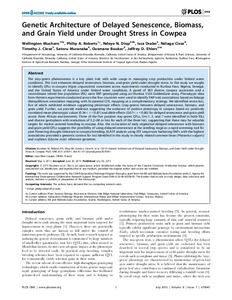| dc.contributor.author | Muchero, W. |
| dc.contributor.author | Roberts, P.A. |
| dc.contributor.author | Diop, N. |
| dc.contributor.author | Drabo, I. |
| dc.contributor.author | Cisse, N. |
| dc.contributor.author | Close, T.J. |
| dc.contributor.author | Muranaka, S. |
| dc.contributor.author | Boukar, O. |
| dc.contributor.author | Ehlers, J.D. |
| dc.date.accessioned | 2019-12-04T11:03:42Z |
| dc.date.available | 2019-12-04T11:03:42Z |
| dc.date.issued | 2013 |
| dc.identifier.citation | Muchero, W., Roberts, P.A., Diop, N., Drabo, I., Cisse, N., Close, T.J., ... & Ehlers, J.D. (2013). Genetic architecture of delayed senescence, biomass, and grain yield under drought stress in cowpea. PloS one 8(7):e70041. |
| dc.identifier.issn | 1932-6203 |
| dc.identifier.uri | https://hdl.handle.net/20.500.12478/1202 |
| dc.description | Cowpea |
| dc.description.abstract | The stay-green phenomenon is a key plant trait with wide usage in managing crop production under limited water conditions. This trait enhances delayed senescence, biomass, and grain yield under drought stress. In this study we sought to identify QTLs in cowpea (Vigna unguiculata) consistent across experiments conducted in Burkina Faso, Nigeria, Senegal, and the United States of America under limited water conditions. A panel of 383 diverse cowpea accessions and a
recombinant inbred line population (RIL) were SNP genotyped using an Illumina 1536 GoldenGate assay. Phenotypic data from thirteen experiments conducted across the four countries were used to identify SNP-trait associations based on linkage disequilibrium association mapping, with bi-parental QTL mapping as a complementary strategy. We identified seven loci, five of which exhibited evidence suggesting pleiotropic effects (stay-green) between delayed senescence, biomass, and grain yield. Further, we provide evidence suggesting the existence of positive pleiotropy in cowpea based on positively correlated mean phenotypic values (0.34, r ,0.87) and allele effects (0.07, r ,0.86) for delayed senescence and grain yield across three African environments. Three of the five putative stay-green QTLs, Dro-1, 3, and 7 were identified in both RILs and diverse germplasm with resolutions of 3.2 cM or less for each of the three loci, suggesting that these may be valuable targets for marker-assisted breeding in cowpea. Also, the co-location of early vegetative delayed senescence with biomass and grain yield QTLs suggests the possibility of using delayed senescence at the seedling stage as a rapid screening tool for post-flowering drought tolerance in cowpea breeding. BLAST analysis using EST sequences harboring SNPs with the highest associations provided a genomic context for loci identified in this study in closely related common bean (Phaseolus vulgaris) and soybean (Glycine max) reference genomes. |
| dc.format.extent | 1-10. |
| dc.language.iso | en |
| dc.subject | Plant Production |
| dc.subject | Cowpeas |
| dc.subject | Genotypes |
| dc.subject | Drought Stress |
| dc.subject | Biomass |
| dc.title | Genetic architecture of delayed senescence, biomass, and grain yield under drought stress in cowpea |
| dc.type | Journal Article |
| dc.description.version | Peer Review |
| cg.contributor.crp | Grain Legumes |
| cg.contributor.affiliation | University of California |
| cg.contributor.affiliation | Institut de l'Environnement et de Recherches Agricoles, Burkina Faso |
| cg.contributor.affiliation | Institut Sénégalais de Recherches Agricoles |
| cg.contributor.affiliation | International Institute of Tropical Agriculture |
| cg.coverage.region | Africa |
| cg.coverage.region | West Africa |
| cg.coverage.country | Senegal |
| cg.coverage.country | Burkina Faso |
| cg.coverage.country | Nigeria |
| cg.isijournal | ISI Journal |
| cg.authorship.types | CGIAR and developing country institute |
| cg.iitasubject | Cowpea |
| cg.journal | PloS one |
| cg.howpublished | Formally Published |
| cg.accessibilitystatus | Open Access |
| local.dspaceid | 78450 |
| cg.targetaudience | Scientists |
| cg.identifier.doi | https://dx.doi.org/10.1371/journal.pone.0070041 |

